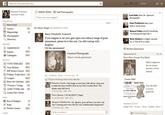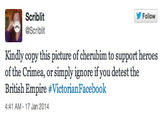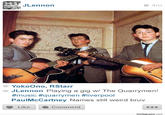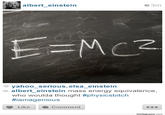Twitter Reenactments
Part of a series on History Fandom. [View Related Entries]
[View Related Sub-entries]
About
Twitter Reeneactments are text-based simulations of a factual event or a fictional story on the microblogging platform. Each project typically involves employing one or more novelty Twitter accounts to publish a series of "real-time" status updates that correspond to the chronological timeline of the original event.
Origin
The first real-time storytelling project on Twitter was started by Utah State University PhD students Marion Jensen and Tom Caswell with the reenactment of the 1863 Battle of Gettysburg[2] over a period of several weeks in April 2009. The retelling of the American Civil War's major battle involved numerous novelty Twitter accounts as proxies of historical figures, including generals and politicians from both The Union and The Confederacy.
I'm announcing to the country that news from Army of the Potomac is such as to cover that army with the highest honor.
— Abraham Lincoln (@Pres_Lincoln) July 4, 2009
Spread
Shortly after the conclusion of the Gettysburg project in July 2009, Jensen and Caswell launched the website TwHistory[1] to serve a resource and an archival place[3] for similar reenactment projects. Over the course of following months, the TwHistory project began to spread through the grapevines of teachers' blogs and educational news sites.
The follow-up project arrived months later in September 2009 with German school teacher Daniel Eisenmenger's history class project "Paulskirchen-Projekt,"[12] which re-enact the German revolutions of 1848. Similar to the Battle of Gettysburg project, Eisenmenger and his students employed numerous novelty accounts to tell the story.
Die Kleindeutsche Lösung ist eine Schande für die Deutschen.Obwohl die Verfassungannehmbar war, kann ich nicht zustimmen! #1849
— C.F.W. Jordan (@cfw_jordan) November 12, 2009
In October 2009, Carla Federman and her students at Mary Institute and Saint Louis Country Day School started a re-enactment project for The Cuban Missile Crisis of 1962, using more than dozen of novelty accounts to represent various politicians and ranking officers in the United States, Cuba and the U.S.S.R.
<a href="https://twitter.com/NikitaKrushche">NikitaKrushche</a>, Cuba should be included in any resolution because missiles in Cuba are not just for the benefit of the USSR.</p>— Fidel Castro (FidelCastro62) October 28, 2009
In March 2010, Rabbi Oren Hayon and a group of his friend began the Twitter reenactment of The Exodus in commemorating the Jewish holiday of Passover. The Twitter account became widely publicized after the Wall Street Journal[8] ran an article titled "How to Perk Up Passover's Plagues? Twitter, Charades and 'Jewpardy'" on March 17th, 2010.
And God spoke all these words, saying: I am the ETERNAL thy God, who brought thee out of the land of Egypt, out of the house of #Torah 1/14
— Temple B'nai Torah (@TempleBnaiTorah) May 25, 2012
The trend of historical reenactments on Twitter gained its largest-scale exposure to date in with the launch of RealTimeWWII, which provided a blow-by-blow reenactment of the World War II events, on August 30th, 2011. The account was created by Oxford University student Alwyn Collinson, who has no formal ties to the TwHistory project.
Collinson's project was picked up by a number of tech news sites[7] and in the span of a few months, the number of followers jumped from 300 subscriptions in September to more than 140,000 subscriptions by mid-November. According to the New York Times[6] article about the blog, RealTimeWWII became so popular that volunteers began translating the RealTimeWWII feed into different languages, including Spanish, Portuguese, Russian, Arabic, Chinese, Turkish, French, Dutch and German.
Notable Examples
The meme soon outgrew its educational purpose and became embraced by others who wanted to commemorate anniversaries or simply to pay tribute to historical figures by tweeting abridged versions of their journal logs.
Historical Reenactments
- The Exodus
- American Revolution
- 1847 Trek of the Mormon Pioneers
- 1848 German Revolutions
- The American Civil War
- The American Civil War #2
- Battle of Gettysburg
- 1912 Antarctic Expedition
- The Maiden Voyage of Titanic
- UK War Cabinet in 1942
- World War II
- 1948 Arab Israeli War
- The Cuban Missile Crisis
- The Apollo 11 Mission
- The Falklands War
- The LA Riots in 1992
- The 9/11 Terrorist Attacks
Histagram
On November 6th, 2013, a single topic Tumblr blog titled "Histagram"[14] was launched to curate Instagram re-enactments of notable events throughout history (shown below).
#VictorianFacebook
On January 17th, 2014, U.K. Twitter user @BuscuitAhoy posted a sub-tweet lamenting about one of her followers who wouldn't stop gossiping, written in the style of a Victorian-era Facebook status update with the hashtag #VictorianFacebook.[15]
I am utterly sickened by that promiscuous woman spreading her infernal gossip. At least I have my relatives for comfort. #VictorianFacebook
— Lisa (@BiscuitAhoy) January 17, 2014 From there, the hashtag quickly took off in the United Kingdom and inspired a series of tweets illustrating humorous snapshots of social media stereotypes set to the backdrop of everyday life in the 1800s. The hashtag was picked up by UK Metro, Huffington Post UK and The Independent later that same day. According to Topsy[16], #VictorianFacebook spawned nearly 9,200 retweets in less than 24 hours.
Adding to the joke, Twitter user @JamieDMJ tweeted a photoshopped screenshot of Facebook dressed in Victorian skin.
Search Interest
[Not currently available.]
External References
[1] TwHistory – About Page
[2] TwHistory – Battle of Gettysburg
[3] TwHistory – Reenactments
[4] TimeToast – Historical Reenactments on Twitter
[5] Historical Tweets – Main Page
[6] New York Times – The Tweets of War: What’s Past Is Postable
writ
fn7. The Next Web – How an ex-History student is using Twitter to bring World War 2 to life
[8] Wall Street Journal – How to Perk Up Passover's Plagues? Twitter, Charades and Jewpardy
[9] TIME – Back To The Future Twitter Reenactment Tonight
[10] Universitat Oberta de Catalunya – TwHistory: Sharing History Using Twitter
[11] Future Educators – Innov8: Twitter + History = TwHistory
[12] Lehrer Online – Mit Blog und Twitter live aus der Paulskirche
[15] Twitter – #VictorianFacebook
[16] The Huffington Post – ""Are You Quite Well, Dearest? Twitter Hashtag #VictorianFacebook Is Inspired And Hilarious
[17] Metro – Gadzooks! #Victorianfacebook trend owns Twitter as users take the hashtag to their hearts
[17] Independent – "The Best of #VictorianFacebook":www.independent.co.uk/voices/iv-drip/the-best-of-victorianfacebook-9067675.html
Recent Videos
There are no videos currently available.






